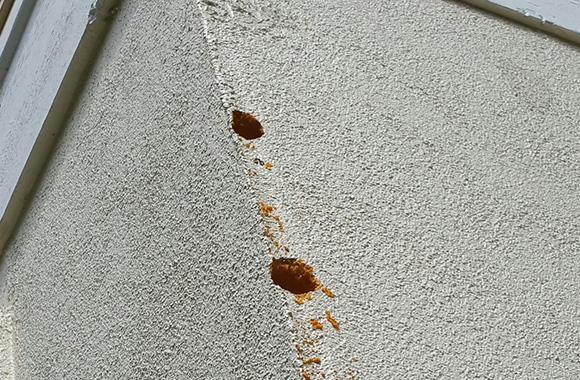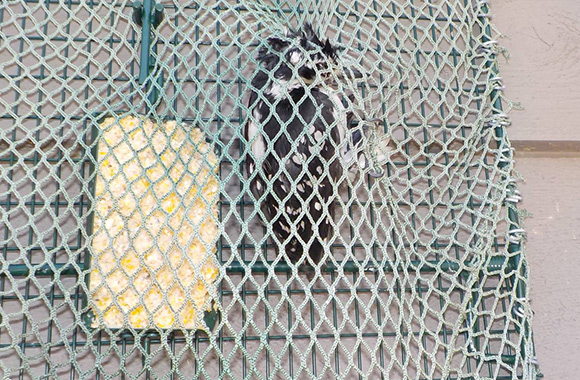Woodpecker damage repair, how to prevent them
Woodpecker holes can be filled with wood putty, or steel mesh with polyurethane overlay. You can go to Home Depot and buy that Great Stuff foam, and spray it in the holes, then once it dries, use a saw to cut it flat, then paint it. But you have to get rid of the woodpeckers before you bother with any repairs.
Woodpeckers, famed as the winged carpenter, have come to be known for their strong affinity to drill holes in wooden structures for their nests. Woodpeckers will not hesitate to drill holes where they find a fine piece of wood that matches their desires and sometimes this can be right on your home or property. Drilling holes can compromise the structural integrity of the house and bring to the fore a multitude of safety issues. Further, abandoned holes can offer refugee to new creatures scavenging for a deserted nest to take over and that goes as far as being your loathed friend, the snake.


Woodpeckers are also known for their drumming habits - which are done for attraction of mates or in guarding territory. While the humming may be soft enough for you to ignore, that may not be the case when you have several of them on your property. This can mean waking you up in early morning, which is a thing you may not be excited about. A combination of humming and drilling will surely make your house a bad place to live. But you don't have to leave the house for the woodpeckers; you can always find a combination of tricks that work well for you. Here is a look into some of the methods you may employ in driving woodpeckers away from your home.
Doing away with the sources of food is the first line of defense against woodpeckers. Woodpeckers will be more likely to stay in a place where they are sure of getting bugs for food and that may just be your home. Some kinds of bees and other insects also form a good delicacy for these birds. Once they have established a close association between free food and your home it will be difficult to get them budge. In order to disorient them start by knocking off these food sources and they will have to forage far from your home. If they manage to locate a new source of food in a distant land then they will be considering a move in the next few days.
Visual deterrents are another formidable option you can deploy against these winged drillers. Thinking of the prowler owl would be a good thing to do. Prowler owls are serious predators of these birds and won't let any of them rest until they have eaten to their fill. Model prowler owls will give woodpeckers a hell of time. Their large reflective eyes will give the bird an impression that it’s being followed, enough reason for it to fly fast and far to a land of no return. Hang the prowler to the sites regularly visited by the birds and you will hammer a spanner in their working.
This tape hanging loosely around the corners these birds love to come peck and drum will also serve as an important distraction. Once the tape moves in the wind humming and reflecting sun rays the birds won't be sure of what exactly they are facing. The more the tape moves and hums the more they will get annoyed. They will also hate it that it hangs around there favorite spots just waiting for them to come in. Once they start feeling unsafe they will likely find new places for their activities.
Terror eyes can also do a good job to give the birds a scare off the places they love to camp out. The reflective eyes that come with these visual deterrents often provide three hundred and sixty degree coverage. The birds can spot them at a distance and continue seeing them even as they move farther. As the gadgets move freely around possible perching places the woodpecker won't be wishing to perch here any longer. It will flee and never come back.
Sound deterrents are also a good option against the birds. Audio recordings of distress signals by woodpeckers followed by sounds of hunting predators like the tight skinned hawks will not impress the wood pecker at all. Better, you can pair these sound deterrents with motion detectors so that the sounds play immediately the woodpeckers attempt landing on the site. Once they are conditioned to avoid these areas they will likely move to new places where they consider safe for their stay.
Use of tactile material on the perching surface is another effective technique to force the woodpecker away. Bird gels will make the surface sticky and slippery - but you are aware that most woodpeckers have that added advantage to sit vertically while pecking on the tree. With tactile material there is no grip here and the feel at their feet is not anywhere near pleasurable. Once they can't stand the conditions around these places they will be seeking to move to a new place where they can drill with comfort.
Finally, tampering with their roots is sufficient to deny the woodpeckers place for a safe stay. Once you discover a drilled out hole, go right here and seal the hole with a shiny aluminum foil. You can then follow up with a new layer of paint. Once the woodpeckers are aware of some human coming around their nests and tampering with their shelter they won't take it lightly. Most of them will be seeking a safe exit before a new trap is laid against them.

If woodpeckers persistently return to your property despite your best deterrent methods, there is a chance that the birds have found a source of food. If the birds are pecking your home, you should check to ensure that the material covering your home isn’t also housing an insect infestation.
Epoxy putty can be used to repair holes in wood caused by woodpeckers. This can be easily masked to look like the rest of the material from your home. Spray foam insulation can be used in the same way. You can use hardware cloth to cover the vulnerable areas until you have managed to permanently eradicate the woodpecker problem.
You will want to keep an eye on things. Woodpeckers frequently return to the same spots, especially when there is a home or food waiting for them. You will need to put property modifications in place that repel or deter the birds, such as netting.

